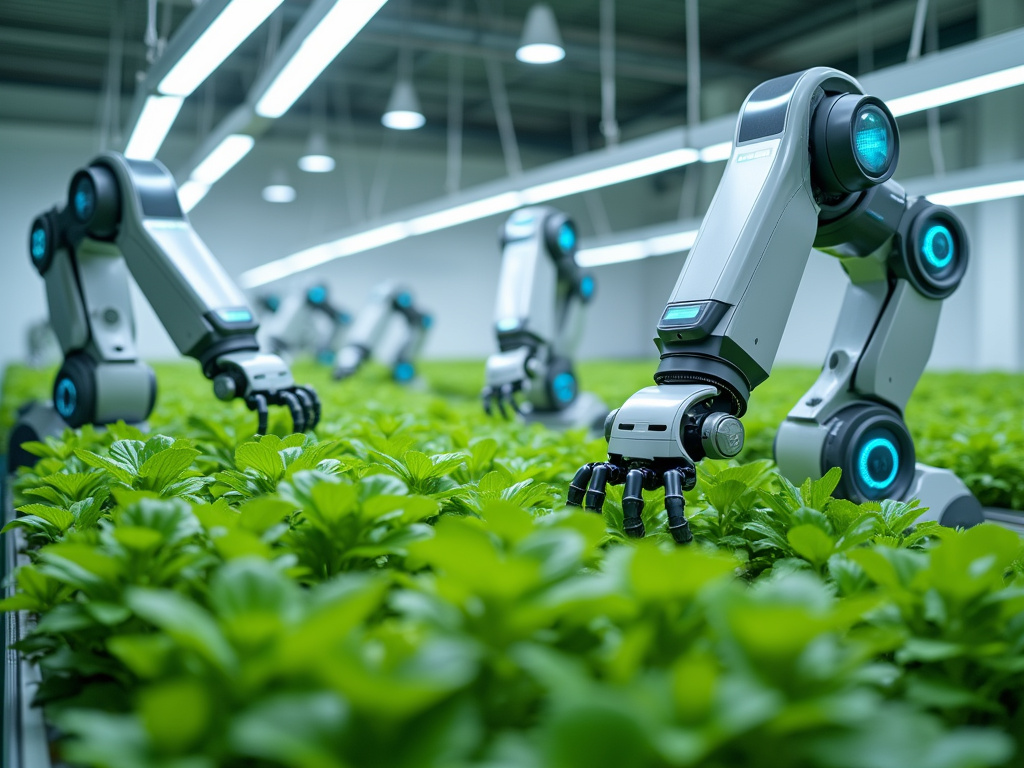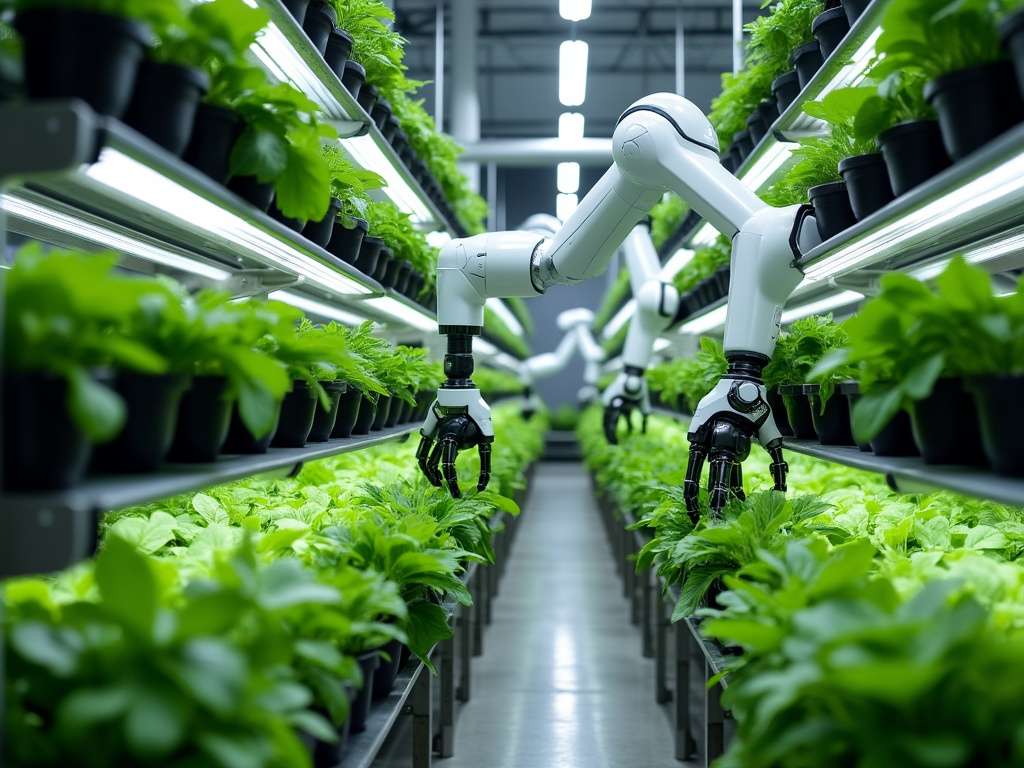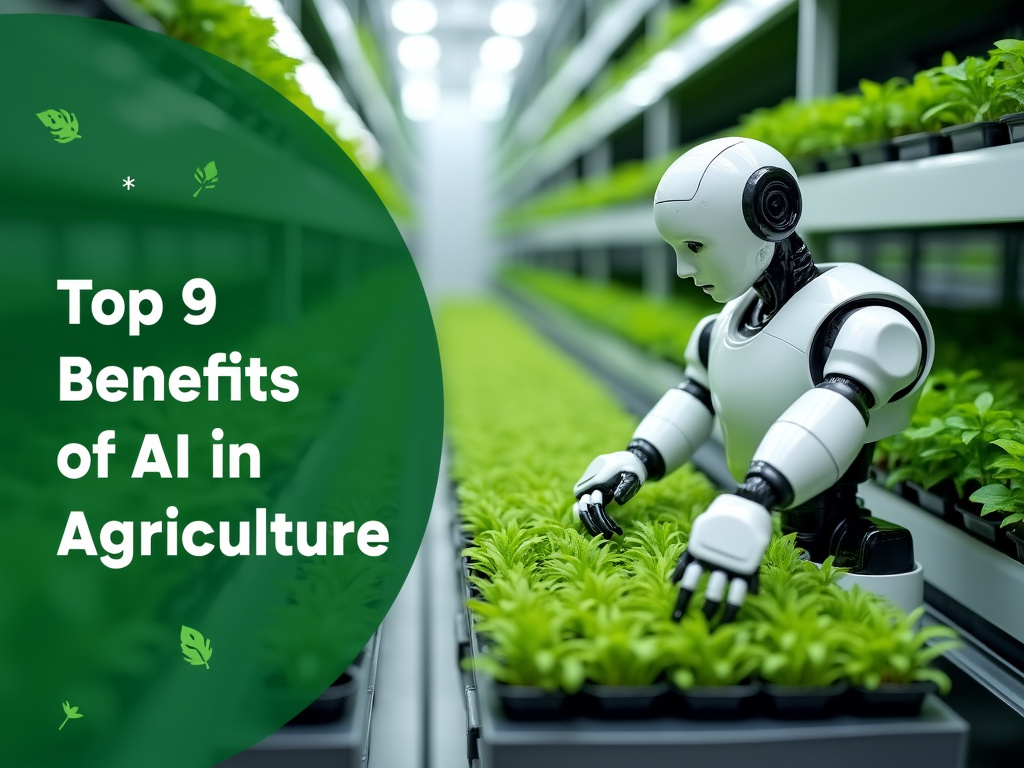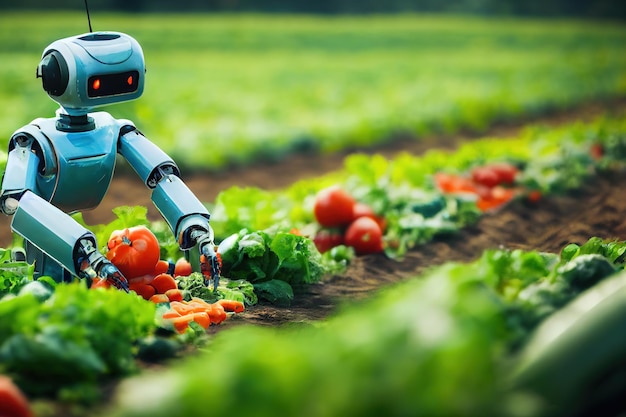Autonomous Agents in Agriculture
Imagine robots tending to crops, drones checking for pests, and smart machines making farming decisions. This isn’t science fiction – it’s the exciting future of farming powered by autonomous agents. These clever computer systems are changing how we grow food in significant ways.
Autonomous agents are digital helpers that can think and act independently. They bring new solutions to old farming problems. In this article, we’ll explore how these high-tech tools are transforming farming. We’ll look at their capabilities, benefits, and some challenges in using them on farms.
Here’s what we’ll cover:
- How autonomous agents work in farming
- The benefits they bring to farms
- Challenges in using them
- The future of autonomous agents in agriculture
Autonomous agents in agriculture are more than just cool gadgets. They are part of a significant change in how we grow food. Using artificial intelligence and machine learning, they make farming smarter and more efficient. Throughout this article, you’ll see how these digital farmhands are enhancing food production in innovative ways.
Historical Context and Current State of AgTech
Agriculture has undergone a remarkable transformation alongside major technological revolutions throughout history. From the invention of the plow to the Green Revolution, farming practices have continuously evolved to meet growing global food demands. Recently, agricultural technology, or AgTech, has surged, promising to reshape the industry once again.
At the heart of this AgTech transformation lies precision farming, a data-driven approach that allows farmers to make highly targeted decisions about crop management. By leveraging tools like GPS-guided tractors, soil sensors, and satellite imagery, farmers can now apply water, fertilizers, and pesticides with pinpoint accuracy. This precision boosts yields and reduces waste and environmental impact.
Data analytics has emerged as a game-changer in modern agriculture. Advanced algorithms process vast amounts of information from various sources—weather patterns, market trends, soil health, and more—to provide actionable insights. For instance, predictive models can help farmers determine the optimal time for planting or harvesting, maximizing crop yields and profitability.
The next frontier in AgTech is the rise of autonomous agents. These AI-powered systems are poised to take precision farming to new heights. Imagine swarms of drones monitoring crop health in real-time, self-driving tractors working around the clock, or robotic harvesters picking fruits at the peak of ripeness. These technologies are already being tested and implemented on farms worldwide.
Autonomous agents offer several key benefits. They can operate 24/7, dramatically increasing efficiency and productivity. They perform tasks with a level of consistency and precision difficult for humans to match. Most importantly, they help address the growing labor shortages in the agricultural sector in many regions.
Looking to the future, AgTech will play a crucial role in meeting the challenges of feeding a growing global population while minimizing environmental impact. The integration of autonomous systems, data analytics, and precision farming techniques represents a paradigm shift in agriculture, promising to make farming smarter, more efficient, and more sustainable than ever before.
AI Agents in Agriculture: Understanding the Essence


Picture a farm where robots tend to crops, drones monitor fields, and computers make critical decisions. This isn’t science fiction – it’s the reality of modern agriculture powered by AI agents. But what exactly are these AI agents, and how are they transforming farming?
AI agents in agriculture are smart computer systems that can think and act on their own to help farmers. They come in many forms, from simple chatbots that answer questions to complex machines that manage entire farms. These digital helpers are ushering in a new age of farming where many tasks happen automatically, without constant human oversight.
Let’s break down some key features of agricultural AI agents:
Autonomous Decision-Making
One of the most impressive abilities of AI agents is making choices on their own. For example, an AI-powered irrigation system might analyze soil moisture, weather forecasts, and crop needs to decide exactly when and how much to water – all without a farmer needing to check. This frees up farmers to focus on other important tasks.
John Gottula, an expert in crop science, explains: AI will form an important basis for reducing labor costs and increasing productivity.
By making smart choices automatically, AI agents help farms run more smoothly and efficiently.
Task Execution
Beyond just making decisions, many AI agents can actually carry out farm work. Imagine robotic arms that carefully prune plants or self-driving tractors that plow fields with precision. These AI-powered machines can work tirelessly, often more accurately than humans.
David Colmenares, a computer vision engineer, predicts: In the future, most manual tasks will be automated, reducing the amount of labor required to grow fresh produce.
This shift allows farmers to spend more time on planning and big-picture thinking.
A Range of Applications
The world of agricultural AI is vast and growing. Here are just a few examples of how these smart agents are being used:
- Chatbots: Answering farmer questions about pest control, equipment, or market prices
- Drones: Surveying fields to spot crop health issues or pest infestations
- Smart sensors: Monitoring soil conditions and plant growth in real-time
- Predictive analytics: Forecasting crop yields and optimal harvest times
- Robotic harvesters: Picking fruits and vegetables with gentle precision
As AI technology advances, we can expect to see even more innovative applications that make farming smarter, more productive, and more sustainable.
Capabilities of AI Agents in AgTech


Robotic arms tending to vibrant green plants.
AI agents are transforming agriculture through innovative applications. These intelligent systems make traditional farming more efficient and sustainable. Here are some key capabilities of AI agents in AgTech:
Intelligent Irrigation Systems
AI in agriculture shines in intelligent irrigation. These systems use machine learning to analyze soil moisture, weather forecasts, and crop water needs. By processing this data, AI makes real-time decisions about irrigation.
Sensors collect soil moisture data, which AI combines with weather predictions and crop-specific water requirements. This analysis allows automatic adjustment of irrigation schedules and water flow, ensuring crops receive the right amount of water at the right time.
This control helps conserve water while optimizing crop growth, especially valuable in water-scarce regions or during droughts.
Drone-Based Crop Monitoring
AI-powered drones are indispensable for modern farmers. Equipped with high-resolution cameras and sensors, they survey large farmland areas, collecting valuable data quickly.
Drones capture detailed images of crops. AI algorithms analyze these images to identify:
- Pest infestations
- Disease outbreaks
- Nutrient deficiencies
- Areas of poor growth
By detecting problems early, farmers can take targeted action before issues spread, potentially saving entire harvests. This precision reduces the need for blanket pesticide or fertilizer applications, which is cost-effective and environmentally friendly.
Process Optimization and Automation
AI agents excel at analyzing large data sets to find patterns and make predictions. In agriculture, this means smarter decision-making and more efficient operations.
AI can process historical crop yield data, soil quality, and climate patterns to recommend optimal planting times and crop rotations. These insights help maximize yields while maintaining soil health.
Furthermore, AI drives the development of autonomous farm equipment. Self-driving tractors guided by AI can plant seeds, apply fertilizers, and harvest crops with minimal human intervention, increasing efficiency and addressing labor shortages.
The Shift Towards Agentic Automation
The integration of AI in agriculture marks a shift towards ‘agentic automation.’ Unlike simple automated systems, AI agents make decisions and adapt to changing conditions.
This capability allows for more responsive and flexible farming practices. An AI agent monitoring a greenhouse can adjust temperature, humidity, and lighting in real-time based on plant needs and external conditions. It learns from past data to improve decision-making, potentially surpassing human expertise.
As AI agents become more sophisticated, they become partners in farm management, handling complex tasks and freeing farmers to focus on strategic planning and innovation.
The future of agriculture is shaped by these intelligent systems, promising increased productivity, sustainability, and resilience in the face of climate change and growing global food demand.
The Agricultural Revolution: AI Agents at the Forefront
Across farms worldwide, a quiet revolution is taking place. Artificial intelligence (AI) agents are transforming agriculture, bringing precision and efficiency to fields cultivated for generations. These AI helpers are not replacing farmers but augmenting their expertise with data-driven insights and automated assistance.
One of the most promising applications of AI in agriculture is predictive analytics for crop yields. By analyzing vast amounts of data on soil conditions, weather patterns, and crop health, AI models can forecast harvests with remarkable accuracy. This allows farmers to plan more effectively, from deciding when to plant to estimating how much produce they will have available for market.
For example, FarmSense, a California startup, has developed an AI-powered sensor called FlightSensor that can identify and count insect pests in real-time. This early warning system enables farmers to take targeted action against potential infestations before they become devastating. As Shailendra Rathod, a cotton farmer in India, puts it:
With AI pest detection, I can spot problems weeks earlier than before. It’s like having a thousand extra eyes watching over my fields day and night.
Automated pest control is another area where AI agents are making a significant impact. Traditional blanket spraying of pesticides is not only expensive but can harm beneficial insects and the environment. AI-powered systems can precisely target only the areas and plants that need treatment, reducing chemical use by up to 90% in some cases.
Perhaps one of the most visible examples of AI in agriculture is the rise of autonomous tractors. These self-driving machines use GPS, sensors, and AI to navigate fields, plant seeds, and harvest crops with minimal human intervention. John Deere, a leader in agricultural machinery, has introduced tractors that can operate around the clock, optimizing field operations and freeing up farmers to focus on other tasks.
The benefits of these AI agents extend beyond just efficiency. They are also improving crop quality by enabling more precise management of water, fertilizer, and other inputs. Farmers can now tailor their approach down to individual plants, ensuring each one gets exactly what it needs to thrive.
As impressive as these advancements are, it is important to remember that AI is a tool to enhance, not replace, human farmers. The deep knowledge and intuition that come from years of working the land remain invaluable. AI agents are partners in this age-old profession, helping to make farming more sustainable, productive, and resilient in the face of global challenges.
The agricultural revolution powered by AI is still in its early stages, but its potential to transform how we grow food is immense. As these technologies become more accessible and affordable, they promise to help farmers around the world produce more food with fewer resources, ensuring a more sustainable future for us all.
Benefits and Challenges of AI Automation in Agriculture


AI enhancing farming with a robotic arm in action.
Artificial intelligence is transforming agriculture, offering both exciting opportunities and complex challenges for farmers and the industry. As AI agents become more prevalent on farms, they drive significant improvements in efficiency and cost-effectiveness. However, this technological shift raises important concerns that need careful attention.
Key Benefits of AI in Agriculture
The adoption of AI in farming operations is yielding impressive results across several areas:
Cost Reductions: AI-powered systems can optimize resource usage, from water and fertilizer to labor and equipment, leading to substantial savings for farmers. For example, precision agriculture techniques enabled by AI can reduce fertilizer and pesticide use by up to 20%, according to some estimates.
Efficiency Improvements: Automated systems can work around the clock, performing tasks like crop monitoring, irrigation, and even harvesting with greater speed and accuracy than human workers. This boost in productivity allows farms to produce more with fewer resources.
Data-Driven Decision Making: AI algorithms can analyze vast amounts of data from sensors, satellites, and other sources to provide farmers with actionable insights. This enables more precise farming practices, optimized for specific field conditions and crop needs.
Challenges to Address
While the potential of AI in agriculture is immense, several significant hurdles need to be overcome:
Data Privacy Concerns: The collection and analysis of farm data raise important questions about privacy and data ownership. Farmers may worry about who has access to sensitive information about their operations and how it might be used. Clear guidelines and robust security measures are essential to build trust in AI systems.
Potential Job Displacement: As AI automates more agricultural tasks, there is understandable concern about the impact on farm labor. While new tech-related jobs may emerge, traditional farming roles could see significant changes or reductions. The industry must proactively address this shift to ensure a just transition for workers.
Technical Complexities: Implementing AI systems on farms can be dauntingly complex, especially for smaller operations with limited resources. The technology requires significant upfront investment and ongoing maintenance and upgrades. Farmers may need extensive training and support to effectively utilize these advanced tools.
Reliability and Connectivity: AI systems often rely on consistent internet connectivity and power supply – resources that may be limited in rural farming areas. Ensuring these systems can function reliably in various environmental conditions is crucial for widespread adoption.
Balancing Progress and Caution
The path forward for AI in agriculture requires a thoughtful approach that maximizes benefits while mitigating risks. Industry stakeholders, policymakers, and farmers must work together to:
- Develop clear standards for data privacy and security in agricultural AI
- Invest in training and education programs to help farmers and workers adapt to new technologies
- Support research into AI solutions tailored for small and medium-sized farms
- Ensure AI systems are designed with the realities of rural infrastructure in mind
By addressing these challenges head-on, the agricultural sector can harness the transformative power of AI while creating a more sustainable and equitable future for farming. The potential rewards – increased food production, reduced environmental impact, and improved farmer livelihoods – make this a worthy goal to pursue.
Future Prospects of AI Agents in Agriculture


A robot carefully collecting fresh vegetables. – Via freepik.com
The farming world is on the brink of a transformation. AI agents are set to enhance agriculture, bringing smarter, more efficient, and climate-resilient farming practices. Innovations are emerging that promise to change how we grow food and manage farms.
One promising development is AI-driven climate-resilient farming. This approach uses AI to help crops thrive despite changing weather patterns. Fields can adapt on their own, adjusting water use and nutrient levels based on real-time climate data. This is the near future of farming.
AI’s potential in agriculture extends beyond climate adaptation. AI agents can revolutionize every aspect of farming, from planting to harvesting. They help farmers make better decisions, spot problems early, and boost crop yields while using fewer resources.
For companies in the agricultural sector, now is the time to act. To stay ahead, businesses need to take strategic steps:
- Invest in AI Platforms
- Upskill the Workforce
- Stay on Top of Emerging Trends
The future of farming looks bright thanks to AI agents. Realizing this potential requires vision, investment, and a willingness to embrace change. For companies ready to take the leap, the rewards could be enormous, both in terms of profits and in creating a more sustainable future for agriculture.
Embracing AI Agents for Agricultural Innovation
AI agents are emerging as powerful catalysts for change in agriculture. These autonomous systems promise to reshape farming practices, driving efficiency and sparking innovation. For farmers, agribusinesses, and policymakers, embracing AI-driven technology is crucial for future growth and sustainability.
AI in agriculture can transform various aspects of farming. From optimizing crop management and predicting yields to enhancing pest control and streamlining supply chains, AI agents offer solutions to age-old challenges while opening doors to new possibilities. The potential for increased productivity, reduced environmental impact, and improved decision-making is immense.
However, the journey toward AI integration in agriculture has its hurdles. Concerns about data privacy, the need for robust infrastructure, and ensuring these technologies benefit farmers of all scales must be addressed. Yet, the benefits far outweigh the challenges, making the adoption of AI agents essential for the agricultural sector.
Looking to the future, platforms like SmythOS play a vital role in making AI technology more accessible to the agricultural community. By providing user-friendly tools for developing and deploying autonomous agents, SmythOS helps bridge the gap between cutting-edge AI capabilities and practical, on-farm applications. Its support for integration with various APIs ensures that these AI agents can seamlessly connect with existing farm management systems and data sources.
The agricultural industry stands at a crossroads. By embracing AI agents and the innovation they bring, we can cultivate a future where farming is more efficient, sustainable, and resilient. The time to act is now. Let’s harness the power of AI to create a smarter, more productive agricultural landscape—one where technology and tradition work together to feed the world and protect our planet for generations to come.
Last updated:
Disclaimer: The information presented in this article is for general informational purposes only and is provided as is. While we strive to keep the content up-to-date and accurate, we make no representations or warranties of any kind, express or implied, about the completeness, accuracy, reliability, suitability, or availability of the information contained in this article.
Any reliance you place on such information is strictly at your own risk. We reserve the right to make additions, deletions, or modifications to the contents of this article at any time without prior notice.
In no event will we be liable for any loss or damage including without limitation, indirect or consequential loss or damage, or any loss or damage whatsoever arising from loss of data, profits, or any other loss not specified herein arising out of, or in connection with, the use of this article.
Despite our best efforts, this article may contain oversights, errors, or omissions. If you notice any inaccuracies or have concerns about the content, please report them through our content feedback form. Your input helps us maintain the quality and reliability of our information.